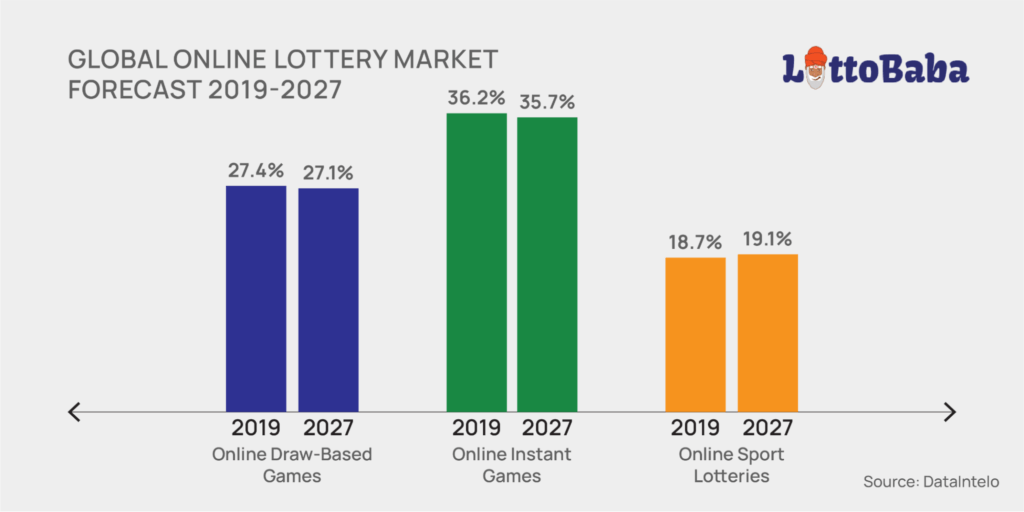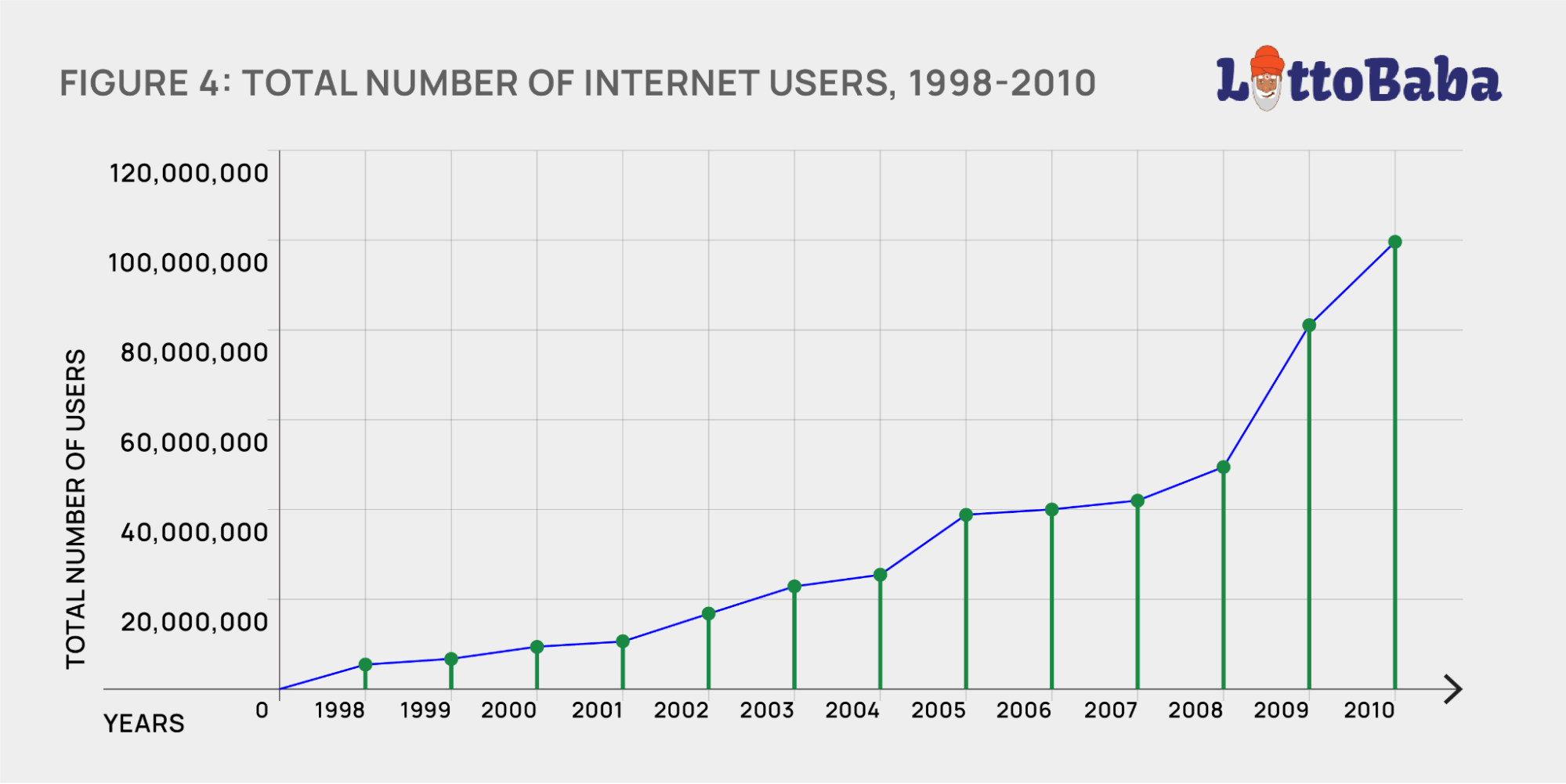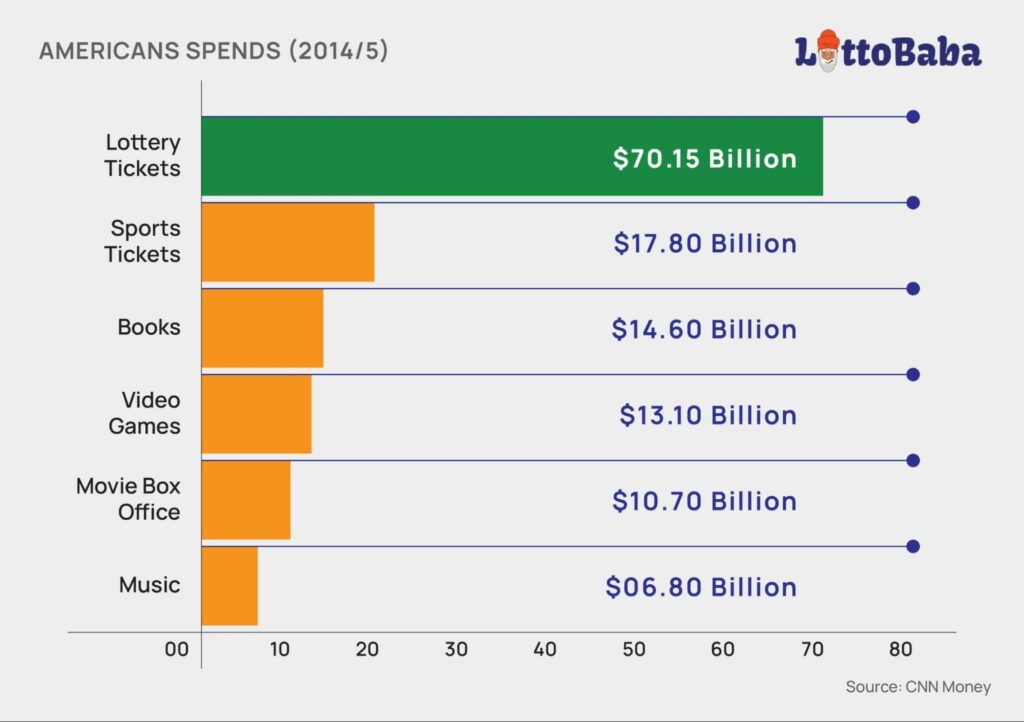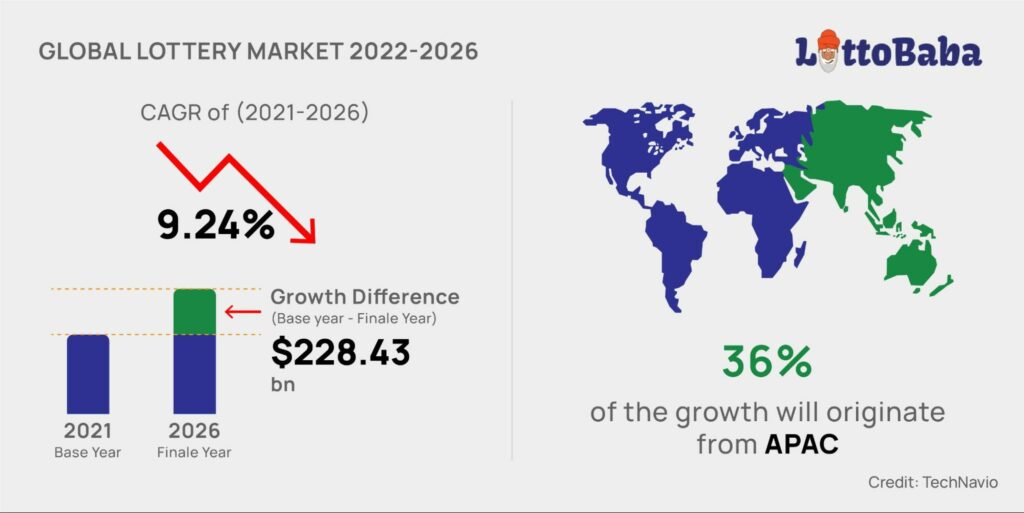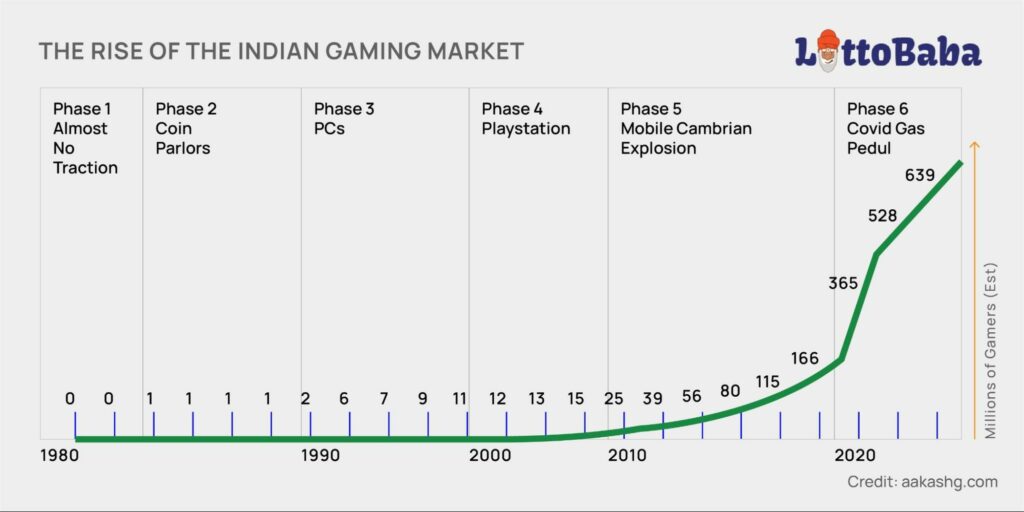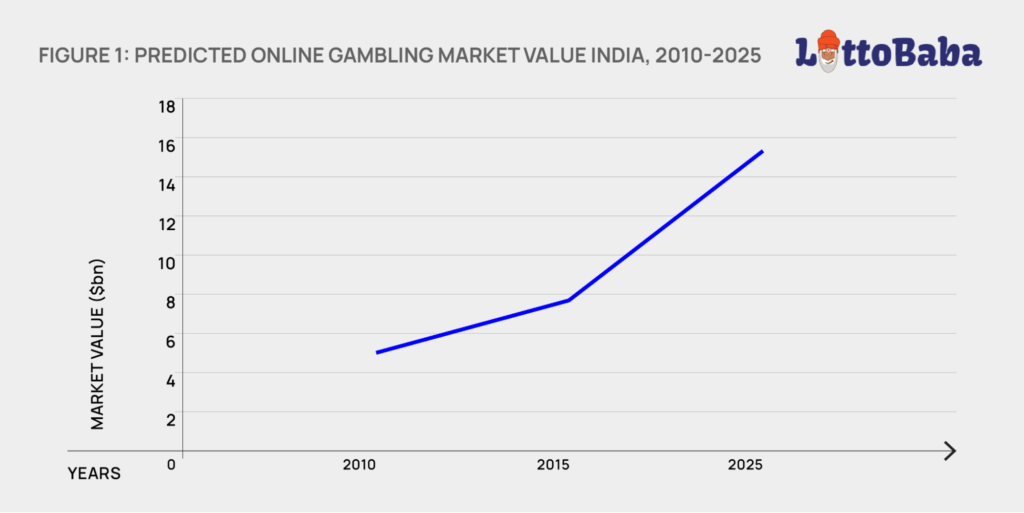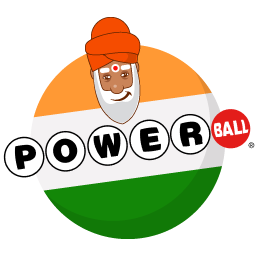While local communities prefer state-conducted legal lotteries playable offline, more people are becoming aware of internet retail, alongside offshore networks that provide access to well-known games from abroad – including the world’s most popular ones like Powerball. That alternative, the online lottery, attracts people with busy schedules who are tech-savvy.
WHO PLAYS ONLINE LOTTERY IN INDIA?
The survey offers some fascinating intuitions into the demographics of lottery players. The larger part of that population is typically young men who reside in large cities. Just out of curiosity, big data alongside scientific research both support the finding that the population tends to have a preference for low-cost alternatives that can result in big wins. In that row, we can consider both stocks of possible turn-around companies and, of course, lotteries.
Source: DataIntelo
According to our findings, lotteries are the most widely used type of gaming in industrialized markets when we consider sports lotteries. The same holds true for Indian states like Goa, which has a lengthy history. That preference becomes clearer when we realize that up to two-thirds of gamblers participate in lotteries, preferring it to casinos or other forms of gambling, and as they get older, they get even more “faithful” to it. After all, they know that they need to keep playing in order to win someday, at least statistically speaking.
Back to the demographics, it seems that young people (18–24) account for up to 35% of the registered users, and individuals under the age of 34 make up a staggering 57% of all users.
When it comes to online gaming in India, Maharashtra continues to be a market to be considered essential, contributing to about 18% of all traffic. That situation was identified halfway through 2021.
IS ONLINE LOTTERY LEGAL IN INDIA?
In India, gambling is typically prohibited in most states, but there are many exceptions when it comes to the lottery. The government oversees the legal lotteries that are offered in the nation. However, there is a reason why “online” gambling is not strictly forbidden. It is not regarded as entirely legal because the Public Gaming Act of 1867, which governs gambling in India, is too old to consider any information connected to the virtual world.
As a result, online gambling, and therefore virtual lotteries, are not illegal everywhere. The operator should be able to provide their services in a state as long as they are based abroad or in areas where lotteries and other kinds of gaming are legal. This is why one can find that online lotteries, casinos, and sportsbooks popular in India are based offshore.
The exception exists, and the states of Andhra Pradesh, Telangana, Punjab, and Tamil Nadu specifically ban any form of online lottery.
(Source: Sharma & Chakraborty, 2019)
The expansion of the number of internet users and the steadily expanding middle class in India has been matched by the explosive rise of the online market. In and of itself, the middle class is anticipated to expand significantly in the upcoming years. To translate that in numbers, India is predicted to have 573 million middle-class citizens by 2025, a lot more than just 40 million in 2007. It goes without saying that they are the public that the online lotteries want to go after.
But this only tells half the story. It is projected that the middle class’ spending patterns will shift as more Indians become middle-class. Additionally, projections have anticipated that middle-class Indians would start spending more money on leisure activities and entertainment during the next ten years, which will likely be advantageous for online gambling. Since that alternative is technically legal in most of the Indian states, the existing websites have a very good projection ahead.
LOTTERIES ARE A STATE BUSINESS
The lotteries in the country are entrusted to each state regulation and are recognized by the Center as a desi gaming tradition. Many years ago, Kerala was the initial region to renounce commercial lotteries and launch a legitimate one in 1967. Other regional governments soon applied a similar approach, and thirteen states permit or administer official lotteries.
The benefits go beyond the revenue to the state. In total, about 10 lakh persons make their living as lottery merchants. Corporate stockists (intermediaries) like Sugal & Damani in Mumbai or Singam in Singapore are given wholesale licenses. As a result, states with lotteries increase their tax income and can allocate more money to social welfare while already allowing individuals to benefit from the sale of tickets.
Interestingly, with more people turning to online lotteries each day, the regional governments still seem to be slow to adapt to the modern world.
TYPES OF AVAILABLE LOTTERIES
The regular Bumper drawings are the two types of lottery draws that most players are familiar with. If you are not familiar with the difference, ordinary drawings can appear multiple times daily, but bumpers are not that regular. They often commemorate holidays and special times like Holi, Diwali, Summer, and Vishnu, appearing up to six times a year.
Among other characteristics, bumper draws include hefty payouts and more expensive tickets. Focused in bumper or ordinary drawings, the paper lotteries are distinguishable from internet lotteries by selling their tickets at streets or stores, which makes them simple to recognize.
The retail of tickets is carried out through intranet sales terminals, limiting locals to the state’s lottery games. Nevertheless, because they prohibit participation in international drawings, those sales are not truly online. According to our data, over 16% of all gaming markets are dominated by lotteries globally. Moreover, games have shifted to the online sphere via smartphone and mobile lottery techniques as more individuals remain at home and businesses go through a big digital change, especially after the pandemic of 2020.
RETAIL CONCERNS
Among the most important concerns that retail and local lotteries have been through, numerous changes have occurred ever since the regime implemented the 28 percent GST in the middle of 2017. Because GST was an indirect levy, retailers were forced to either increase ultimate prices or decrease jackpots in order to pass the cost on to customers. Prizes being the most alluring aspect of playing the game, the tickets had their price increased, which led to the emergence of unauthorized gaming around the country.
The rise in the black market rivalry led to the demise of Essel Group, one of the country’s most well-known operators. In a perfect storm, the slew of shutdowns and issues brought on by the coronavirus rendered the business unviable for the majority of shops.
The current data still shows that offline state-run legal lotteries are preferred by local communities, but more individuals are becoming aware of how online retail from abroad works and of the offshore networks that offer access to well-known games.
THE SCOPE OF INDIA’S OFFLINE AND ONLINE LOTTERIES
It is actually hard to collect data to compare how offline and online lotteries have developed over the last years. The state governments’ incompetence (or unwillingness) to digitize their games and information makes them challenging to check and evaluate. It is known that, before the implementation of the GST, industry estimates put the market’s annual revenue at 60,000 crore.
According to the offered organic information, online lotteries are still insignificant in comparison to their traditional counterparts. It is, nonetheless, a rapidly expanding market section, and the protection of the identity of users probably underestimates their participation in online lotteries.
Paper-founded lotteries depend on a million retail locations, but many of them have shut down, forcing state finance authorities to make some difficult choices. However, we have not seen the results of that need yet.
(Source: CNN money)
ONLINE VISIBILITY OF LOTTERY DEMAND
According to the media analysis, combined lottery queries account for up to 24% of the organic data on most of its top gaming partner sites. The historical data we had access to exhibited a propensity to shift to well-known games and conventional lotteries during the initial round of lockdowns, a pattern that should be changing at this point with the broad offer of different games online.
Up to eight million lookups for the lottery are combined among the top 20 websites, showing a steady trend over the last six to twelve months. That need for the lottery is strong across networks, with the traditional lottery being outpaced by online lottery, particularly in states where the options are scarce.
GOVERNMENT LOTTERIES IN INDIA, STATE-BY-STATE
The Indian government lotteries were examined in the report since they are still an important part of lottery participation in India. In terms of the lottery program with the biggest public in the nation, the Kerala drawing comes first, although the Nagaland lottery has national significance. There are cases of multistate offers, such as the Dear Lottery, which is sold in Sikkim as well as West Bengal and other regions. Also popular due to the cheaper lottery tickets, we have to mention the Lottery Sambad.
In most of the thirteen states in India where there is a running government lottery, there are numerous daily draws as well as some Bumper jackpots.
An interesting fact about government lotteries is that many state governments advertise big jackpots and promote their lotteries as “investment” opportunities. Others emphasize the significance of the schemes in providing funding for infrastructure, education, or health-related projects while offering a chance to win prizes.
ONLINE LOTTERY MARKET LEADERS
Additionally, our survey resulted in a list of the top online lottery websites accessible from India. The three companies at the top of the market are LottoSmile (or TheLotter), which offers more than fifty lotteries from across the globe, Lottoland.Asia, which offers more than thirty lotteries, and LottoSmile, focused on a welcome bonus for new players.
Among the opportunities found on those websites, players find renowned American, European, and Australian games like MegaMillions, EuroMillions, SuperEnalotto, and many others available for purchase.
Aside from singular tickets, syndicates and individual bundles with discounts are available options. Opening opportunities to other industries, most players also rely on some straightforward blogs for tips to play those lottery games from abroad.
(Source: Technavio)
THE FUTURE OF INDIA’S LOTTERY MARKET
At the moment, the lotteries in Bharat (India) are a significant economic segment currently conquered by public entities, with steady demand and ingrained traditions, slowly losing market share and control to foreign companies. The expected Union’s digital transition and the existence of certain fiercely competitive onshore and phone lottery companies will probably cause market disruption in the future.
The ability of lotteries to foster optimism during difficult times has been demonstrated by scientists. In the situation initiated by the pandemic, internet channels can make up for and even outperform sluggish in-person retail sales. Among the lessons and expectations for the future, we find it essential to highlight:
- Government-managed lotteries must make investments in technological advancements and internet operations for legal lottery games in India if they do not want to lose the trust of participants. A shift to online sales will improve consumer safety standards while providing lottery players better prizes as well as cash-out alternatives and open up employment opportunities.
- Long-term projections of the lottery market’s growth and scope in India entail numerous levels of assumptions. The scale of the entire sector is probably going to increase according to India’s population and inflation rates, given its steady demand and deeply ingrained cultural foundations.
On the other hand, the structural relationship between offline and online lottery segments is anticipated to change as a result of the dramatic changes in all sectors brought on by digitization.
It is important to say that the new payment methods and channels have an effect on the economy as well. After all, the ease of buying something in general influences how much entertainment is consumed, ultimately involving both those parallel and opposed lottery “dimensions.” With the majority of the 650 million internet users in the Union having access to fintech solutions, Desi clients have already moved beyond bank cards in remote places with e-wallets and direct transfers.
At some point, the dynamics of the lottery market will also mirror regional and worldwide economic cycles. The Covid-19 pandemic-related worldwide force majeure events are blamed for the current downturn, and physical location closures have many small-time shops worried about their financial survival. Since all forms of gaming and gambling seem to have adapted well to that transformation, they do have a reason to be worried.
(Source: aakashg.com)
Many people are drawn to the allure of the potential to improve their financial status through lottery prizes (and small investments). Lotteries are more relevant than ever in uncertain times, according to a study by Kantar in Australia, because they have the capacity to boost optimism. We can state with confidence that Indian players follow this tendency in both stocks and lotteries.
The UK National Lottery sales have also demonstrated that any retail declines in physical retail locations may be made up for (and even exceeded) by digital channels. Even that one example should suffice for Indian states to begin their adaptation plan.
The aforementioned statistics and developments serve as a reminder that, in the modern world, the digital dimension is crucial. Although India’s banking and fintech sectors are prepared for the new era, many conventional industries, such as state government lotteries, may not be. Mobile apps, which are essential in every other commercial and even social sector, are a prime example and are used by online lottery market leaders.
LARGE INDIA CITIES, A HUGE MARKET FOR LOTTERY
We already know that government reports on the gambling industry in India are rare, especially those on state lotteries. Fortunately for us, recent research gives a vivid picture of how the domestic gaming market is thriving both offline and online.
- Maharashtra deserves to be highlighted due to its Tier-1 cities like Mumbai, as well as Pune, and it is “a market to be respected” in terms of online blackjack gambling, accounting for over 24 percent of user traffic and revenue. The segmented aggregate data of 77,000 users who visited an online gambling website in the first few months of 2021 were used in the report. People already feel safer playing online, and that should apply to lotteries as well.
- Telangana is in second place, followed by Tamil Nadu (8.93 percent of user traffic, 9.18 percent of sessions despite the prohibition), Karnataka (8.42 percent of user traffic, 8.56 percent of sessions), and West Bengal (10.02 percent of user traffic, 9.19 percent of sessions).
It is important to notice that practically every other state that led the list, with the exception of Maharashtra, Karnataka, and West Bengal, does not have a legal lottery within its borders. Currently, 13 states in the nation allow the selling of paper (physical) lottery tickets, and most of the 17 remaining states have no prohibition on online lotteries from abroad.
Cities and States with a high population density are important for measuring the establishment of any trend, as are cultural norms and consumption patterns. Since they are quite diverse in those aspects, we always need to consider several states at once.
Also, the legal and distribution coverage concerns, for example, seem to be able to be solved by these primary criteria if the local legislative takes its time to consider that need. It is equally obvious, though, that many regions of India without access to official State-conducted lotteries are going to look for alternatives, whether online or in the illicit sector (physical shops).
CHANGING TIMES, A CATALYST FOR INDIA LOTTERY'S ONLINE ADOPTION
The first state lottery was established in Kerala in 1967. Therefore, the lottery has a long history in India. Nowadays, lottery tickets are still sold through stores and managed by a central server run by the state government, but the constantly evolving world may well be the impetus for operators to switch to entirely online lottery operations.
Still talking about Kerala, which has been accused of smuggling tickets out of the state in bulk, the state could considerably profit from digitizing its entire lottery industry, given that the state has the second-highest statewide internet penetration rate at 56 percent. The need for online lotteries is expected to rise in the upcoming years, and it will lose a large source of income if it does not adapt soon.
Thanks to the current legislation at a national level, the state has what it needs to create its own online lottery. However, that unexplainable delay continues to haunt Indian states and players.
In addition, it is safe to say that online lotteries would not replace local lotteries. The online distribution will also make paper-based lotteries more effective and accessible in areas where they are still the norm, and they could co-exist. Draw-based plays (like online bingo, for example) are also probable to develop instead of seeing a decline in market share given the steady degrees of lottery demand and levels of technology adoption within the Union.
A $10 BILLION INDUSTRY THAT ACCOMPANIES DEVELOPMENT
- According to some sources, gambling predates civilization itself. It should come as no surprise that Indians enjoy gambling, given that some of the world’s earliest civilizations were born there.
- The gambling industry in general, and online gambling in particular, is increasing in India thanks to the country’s thriving economy, expanding middle class, and quickly growing internet infrastructure.
In light of those two important points, it makes sense that the Indian government would want to ensure that it receives a share of the profits, right? However, due to outdated laws, some of which date back to the colonial era, gambling is still mostly unregulated in India, both offline and online.
(Source: Ansari et al., 2020)
Ironically, it is difficult to determine the extent of the gambling market in India due to the lack of regulation. However, it is estimated that the gambling industry overall, including both online and offline games, is currently worth more than $10 billion.
Given that online gambling is typically associated with the middle class, the expansion of India’s middle class should cause this industry to experience substantial growth between now and 2025, as shown in Figure 1 above.
HANDSOME STATE REVENUES
Going the opposite way in terms of regulation, online gambling is being welcomed more and more in the West. It is already regulated in nations like Italy and the United Kingdom, opening up new avenues for tax revenue.
Of course, every nation has a different tax structure that focuses either on the net or gross revenues. Generally speaking, the tax rates levied range from 17 to 30 percent, according to the preferences and needs of each nation. Such a tax structure might be worth as much as $1.6 billion to India right away, but there is no sign of implementation to adapt to online lotteries.
Based on the anticipated market value in figure 1, the following table to show how much a gross revenue tax imposed on operators could be worth:
| Gross Tax Rate | 2010 | 2015 | 2025 |
|---|---|---|---|
| 15% | $0.75bn | $1.16bn | $2.31bn |
| 20% | $1bn | $1.54bn | $3.08bn |
| 25% | $1.25bn | $1.93bn | $3.85bn |
| 30% | $1.50bn | $2.31bn | $4.62bn |
(Source: mymoneysage.in)
As a result of legislation requiring foreign operators to cooperate with Indian businesses, the acquisition of licenses by foreign operators would also lead to additional foreign investment in India. The expansion of India’s middle class and the country’s internet penetration are the two reasons driving the growth of the country’s online gambling business. By the standards of wealthy countries, both are still minimal, but they are expanding quickly enough not to ignore that investment.
To give you an idea by comparing different nations, the number of internet users in India is thought to have surpassed 200 million in 2010 or 2011 (source: Internet World Stats), or just under 10% of the country’s total population. This number is low even when compared to other recently industrialized nations like China (35.3%). Also, it is obvious that India still has a long way to go before the internet is as widely used as it is in countries like the United States (78 percent), Japan (85 percent), Germany (82.85 percent), and the United Kingdom (85 percent).
In light of that comparison with the data that we collected, either India will begin its adaptation immediately or the foreign lottery sites will profit enormously without the adequate transfer to those in need through tax income.
References
- Joshipura, M. (2021). Leverage constraints or preference for lottery: What explains the low-risk effect in India?. Shilpa Peswani and Mayank Joshipura (2021). Leverage constraints or preference for lottery: What explains the low-risk effect in India, 48-63.
- papers.ssrn.com
- businessinsider.in
- indiatimes.com


